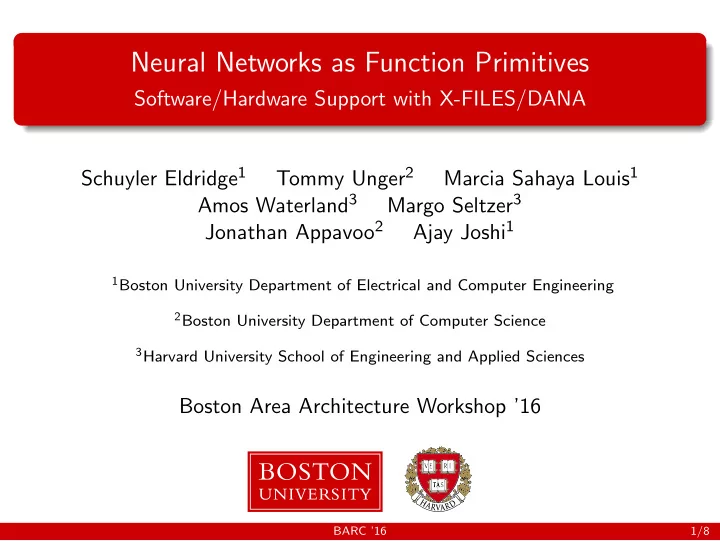

Neural Networks as Function Primitives Software/Hardware Support with X-FILES/DANA Schuyler Eldridge 1 Tommy Unger 2 Marcia Sahaya Louis 1 Amos Waterland 3 Margo Seltzer 3 Jonathan Appavoo 2 Ajay Joshi 1 1 Boston University Department of Electrical and Computer Engineering 2 Boston University Department of Computer Science 3 Harvard University School of Engineering and Applied Sciences Boston Area Architecture Workshop ’16 BARC ’16 1/8
Neural Networks as Function Primitives Motivation Neural networks and machine learning are everywhere ( again ) Broad use in high tech and big data, e.g., Google’s Tensorflow [1] Enable automatic parallelization, e.g., ASC [3] Provide a means for approximate computing, e.g., NPU [2] Our vision Neural networks are a new functional primitive useful at various scales of computation [4] With that in mind, we’ve developed software and hardware for the use of accelerator-backed neural network computation [1] Google TensorFlow, https://github.com/tensorflow/tensorflow [2] H. Esmaeilzadeh, A. Sampson et al. , “Neural acceleration for general-purpose approximate programs,” in Proc. MICRO , 2012. [3] A. Waterland, E. Angelino, R. P. Adams, J. Appavoo, and M. Seltzer, “Asc: Automatically scalable computation,” in Proc. ASPLOS , 2014. [4] S. Eldridge, A. Waterland et al. , “Towards general-purpose neural network computing,” in Proc. PACT , 2015. BARC ’16 2/8
Our Contributions Towards this Vision X-FILES: Software/Hardware Extensions E x tensions f or the I ntegration of Machine L earning in E veryday S ystems A defined user and supervisor interface for neural networks This includes supervisor architectural state (hardware) DANA: An Example Multi-Transaction Accelerator D ynamically A llocated N eural Network A ccelerator An accelerator aligning with our multi transaction vision Neural Network Transactions A transaction encapsulates a request by a process to compute the output of a specific neural network for a provided input BARC ’16 3/8
Or: A Drop in Accelerator for a RISC-V Microprocessor What does that mean? 1 Grab a Rocket Chip RISC-V Microprocessor [1] 2 Build a RISC-V toolchain 3 Grab a copy of our X-FILES/DANA accelerator [2] Implemented in Chisel [3] 4 Build an FPGA configuration for Rocket + X-FILES/DANA 5 User processes can safely throw transactions at X-FILES hardware With support for feedforward and learning computation [1] Rocket Chip git repository, UC Berkeley, Online: github.com/ucb-bar/rocket-chip [2] X-FILES/DANA git repository, Boston University, Online ( soon !): github.com/bu-icsg/xfiles-dana [3] J. Bachrach, H. Vo, B. Richards, Y. Lee, A. Waterman, R. Aviˇ zienis et al. , “Chisel: Constructing hardware in a scala embedded language,” in Proc. DAC , 2012, pp. 1216–1225. BARC ’16 4/8
X-FILES Software Components Supervisor API Establishes sets of processes that can access neural network hardware Defines the neural networks that processes are allowed to access More details on the poster! User API Works at the level of transactions A complete request for access to neural network resources, communication of inputs, processing, and communication of outputs Initiating a new transaction Writing data Reading data BARC ’16 5/8
X-FILES/DANA Hardware Rocket PE Table Core Local State Storage L1$ PE Configuration Cache ASID NNID State ASID Transaction Table ASID TID NNID State ASID-NNID Control Table Num ASIDs Walker RR Cache Arbiter Memory ASID-NNID Table Pointer X-Files Hardware Arbiter DANA Accelerator Figure: X-FILES/DANA hardware architecture Components X-FILES Hardware Arbiter maintaining transaction state DANA to move transactions towards completion With support for feedforward or learning computation BARC ’16 6/8
Open Source Plans Remaining Items Linux kernel integration Support for asynchronous data transfer Open Source Availability Should be ready by the end of February On GitHub: github.com/bu-icsg/xfiles-dana BARC ’16 7/8
Acknowledgments This work was supported by the following: A NASA Space Technology Research Fellowship An NSF Graduate Research Fellowship NSF CAREER awards A Google Faculty Research Award BARC ’16 8/8
Recommend
More recommend